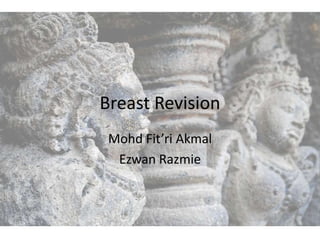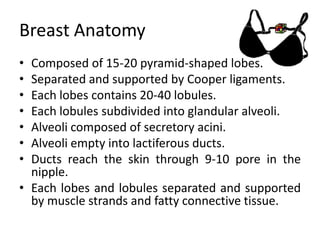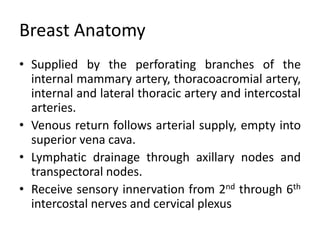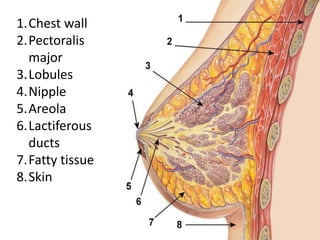Breast anatomy&physiology
- 1. Breast Revision Mohd Fit’ri Akmal Ezwan Razmie
- 2. Breast Anatomy • Composed of 15-20 pyramid-shaped lobes. • Separated and supported by Cooper ligaments. • Each lobes contains 20-40 lobules. • Each lobules subdivided into glandular alveoli. • Alveoli composed of secretory acini. • Alveoli empty into lactiferous ducts. • Ducts reach the skin through 9-10 pore in the nipple. • Each lobes and lobules separated and supported by muscle strands and fatty connective tissue.
- 3. Breast Anatomy • Supplied by the perforating branches of the internal mammary artery, thoracoacromial artery, internal and lateral thoracic artery and intercostal arteries. • Venous return follows arterial supply, empty into superior vena cava. • Lymphatic drainage through axillary nodes and transpectoral nodes. • Receive sensory innervation from 2nd through 6th intercostal nerves and cervical plexus
- 4. 1.Chest wall 2.Pectoralis major 3.Lobules 4.Nipple 5.Areola 6.Lactiferous ducts 7.Fatty tissue 8.Skin
- 5. Nipple & Areola Anatomy • Nipple is a pigmented, cylindrical structure. • Usually located at the 4th or 5th intercostal space. • On surface, lies multiple openings. One from each lobes. • Areola is the circular pigmented area surrounding the nipple. • Contains a number of Montgomery glands.
- 6. Nipple & Areola Anatomy • Nipple and areola contains smooth muscle. • Motor innervation from sympathetic nervous system.
- 8. Breast Physiology Stage Development Fetal Breast tissue begins to develop around the sixth week in utero. Development Prepuberty Ducts are present but nonfunctional – resting state. Puberty Ducts elongate due to estrogen; breast bud appears. Young Adult Progesterone influence initiation of ovulation; ducts elongate; side branches of ducts and lobular elements form. Maturity Lobular elements are well formed. Pregnancy Distal ducts grow and branch; breast enlarge to twice it’s normal weight; increase in mammary blood flow; vascular engorgement and areolar pigmentation. Menopause Lobules begin to recede, leaving mostly ducts, adipose tissue and fibrous tissue.
- 9. References 1. Pathophysiology 6th edition 2. http://www.medscape.org/viewarticle/5489 21_5









